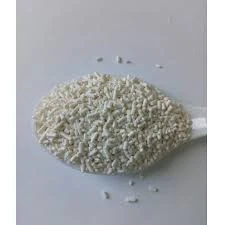
Exploring the Benefits and Applications of E481 Emulsifier in Food Industry
Understanding E481 Emulsifier Properties, Uses, and Safety Concerns
Emulsifiers play an essential role in food technology, acting as stabilizing agents that help to mix two immiscible liquids, such as oil and water. Among various emulsifiers, E481, also known as sodium stearoyl lactylate, has garnered attention in the food industry for its multifunctional properties. This article explores the characteristics, applications, and safety considerations of E481 emulsifier.
What is E481?
E481 is a food additive derived from the reaction between stearic acid and lactic acid. It functions primarily as a food emulsifier and is often used in conjunction with other emulsifiers to enhance its effectiveness. The structural composition of E481 allows it to interact with both hydrophilic (water-attracting) and hydrophobic (water-repelling) components, creating stable emulsions essential for various food products.
Properties of E481
One of the distinctive properties of E481 is its ability to improve texture and extend shelf-life in food products. It stabilizes emulsions, preventing the separation of liquid phases and maintaining a uniform consistency. E481 also possesses significant anti-staling properties, making it particularly valuable in baked goods. The emulsifier can retain moisture, soften the texture of bread, and prolong freshness, enhancing consumer satisfaction and reducing food waste.
Additionally, E481 exhibits surfactant properties, which help reduce the surface tension between different phases in food mixtures. This characteristic is particularly beneficial in products that require foaming, such as whipped toppings, whereby E481 helps create stable foams that retain their structure over time.
Uses of E481 in Food Products
e481 emulsifier

E481 is commonly used in a wide range of food applications. In the bakery industry, it is a key ingredient in bread, cakes, and pastries, where it enhances dough stability and improves the final texture of baked goods. Its moisture retention capabilities are particularly advantageous in sandwich breads, where stale bread can compromise product quality.
Beyond baked goods, E481 is used in dairy products, margarine, and processed foods. It serves as an emulsifier in salad dressings, sauces, and spreads, preventing separation and enhancing mouthfeel. E481 is also found in confectionery products, imparting a smooth texture to chocolates and gummy candies.
In the realm of non-food applications, E481 is utilized in cosmetics and personal care products as a stabilizing and emulsifying agent, showcasing its versatility beyond just food.
Safety and Regulation
E481 is classified as a food additive by regulatory bodies such as the European Food Safety Authority (EFSA) and the US Food and Drug Administration (FDA). These organizations have assessed its safety and established acceptable daily intake levels, which support its use in various food applications. Generally, E481 is regarded as safe when consumed within the recommended limits.
However, some individuals may have sensitivities to emulsifiers, leading to potential digestive discomfort. While adverse reactions are relatively rare, manufacturers are encouraged to appropriately label products containing E481, enabling consumers to make informed choices.
Conclusion
E481 emulsifier, or sodium stearoyl lactylate, is a valuable additive in the food industry with multifunctional properties that enhance the quality and shelf-life of various food products. Its ability to stabilize emulsions, retain moisture, and improve texture makes it a go-to choice for bakers and manufacturers alike. While considered safe by regulatory agencies, consumers should remain informed about potential sensitivities associated with emulsifiers. As the food industry continues to evolve with a focus on quality and stability, E481 will likely remain an integral part of many formulations, contributing to the enjoyment of food products around the world.
-
Understanding Synthetic Rubber OptionsNewsApr.27,2025
-
Trichloroisocyanuric Acid: Essential for Clean and Safe WaterNewsApr.27,2025
-
Sodium Dichloroisocyanurate: Key to Safe Water TreatmentNewsApr.27,2025
-
Sodium Acid Pyrophosphate: Essential in Modern Food ProcessingNewsApr.27,2025
-
Essential Water Treatment ChemicalsNewsApr.27,2025
-
Denatured Alcohol and Its Industrial UsesNewsApr.27,2025
-
The Versatile Uses of Sodium BicarbonateNewsApr.24,2025
Hebei Tenger Chemical Technology Co., Ltd. focuses on the chemical industry and is committed to the export service of chemical raw materials.
-

view more DiethanolisopropanolamineIn the ever-growing field of chemical solutions, diethanolisopropanolamine (DEIPA) stands out as a versatile and important compound. Due to its unique chemical structure and properties, DEIPA is of interest to various industries including construction, personal care, and agriculture. -

view more TriisopropanolamineTriisopropanolamine (TIPA) alkanol amine substance, is a kind of alcohol amine compound with amino and alcohol hydroxyl, and because of its molecules contains both amino and hydroxyl. -

view more Tetramethyl Thiuram DisulfideTetramethyl thiuram disulfide, also known as TMTD, is a white to light-yellow powder with a distinct sulfur-like odor. It is soluble in organic solvents such as benzene, acetone, and ethyl acetate, making it highly versatile for use in different formulations. TMTD is known for its excellent vulcanization acceleration properties, which makes it a key ingredient in the production of rubber products. Additionally, it acts as an effective fungicide and bactericide, making it valuable in agricultural applications. Its high purity and stability ensure consistent performance, making it a preferred choice for manufacturers across various industries.











